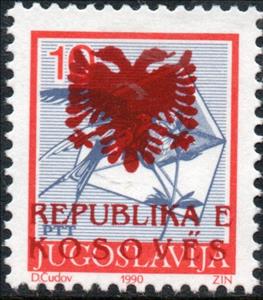Stamp: Red Eagle overprint (Cinderellas 1993)
Red Eagle overprint (Cinderellas 1993)
01 January (Cinderellas ) within release Kosovo goes into circulation Stamp Red Eagle overprint face value 10 Yugoslav dinar
| Stamp Red Eagle overprint in catalogues | |
|---|---|
| Colnect codes: | Col: YU-KO 1993-01/01 |
Stamp is vertical format.
Red eagle Republika E Kosoves overprint on Mi:YU 2429C stamp issued in 1990Also in the issue Kosovo:
- Stamp - Red Eagle overprint face value 10;
- Stamp - Red Eagle overprint face value 3;
- Stamp - Red Eagle overprint face value 0.50;
- Stamp - Red Eagle overprint face value 2;
- Stamp - Red Eagle overprint face value 93;
- Stamp - Red Eagle overprint face value 60;
- Stamp - Red Eagle overprint face value 220;
- Stamp - Red Eagle overprint face value 30;
- Stamp - Red Eagle overprint face value 0.40;
- Stamp - Red Eagle overprint face value 5;
Stamp Red Eagle overprint it reflects the thematic directions:
Birds (Aves), a subgroup of Reptiles, are the last living examples of Dinosaurs. They are a group of endothermic vertebrates, characterised by feathers, toothless beaked jaws, the laying of hard-shelled eggs, a high metabolic rate, a four-chambered heart, and a strong yet lightweight skeleton. Birds live worldwide and range in size from the 5 cm (2 in) bee hummingbird to the 2.75 m (9 ft) ostrich. They rank as the class of tetrapods with the most living species, at approximately ten thousand, with more than half of these being passerines, sometimes known as perching birds. Birds are the closest living relatives of crocodilians.
Eagle is the common name for the golden eagle, bald eagle, and other birds of prey in the family Accipitridae. Eagles belong to several groups of genera, some of which are closely related. True eagles comprise the genus Aquila. Most of the 68 species of eagles are from Eurasia and Africa. Outside this area, just 14 species can be found—two in North America, nine in Central and South America, and three in Australia.
A flower, sometimes known as a bloom or blossom, is the reproductive structure found in plants that are floral (plants of the division Magnoliophyta, also called angiosperms). The biological function of a flower is to effect reproduction, usually by providing a mechanism for the union of sperm with eggs. Flowers may facilitate outcrossing (fusion of sperm and eggs from different individuals in a population) or allow selfing (fusion of sperm and egg from the same flower). Some flowers produce diaspores without fertilization (parthenocarpy). Flowers contain sporangia and are the site where gametophytes develop. Many flowers have evolved to be attractive to animals, so as to cause them to be vectors for the transfer of pollen. After fertilization, the ovary of the flower develops into fruit containing seeds. In addition to facilitating the reproduction of flowering plants, flowers have long been admired and used by humans to beautify their environment, and also as objects of romance, ritual, religion, medicine and as a source of food.



